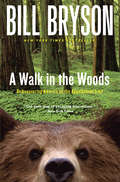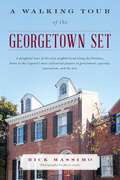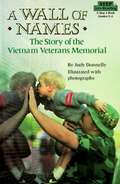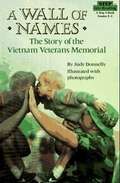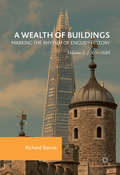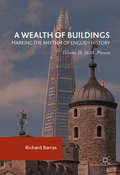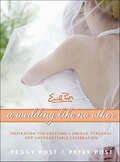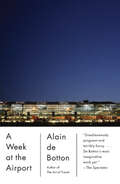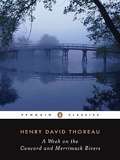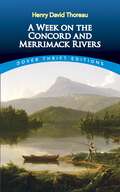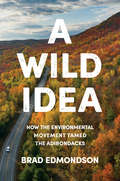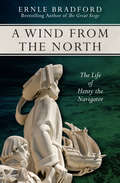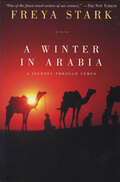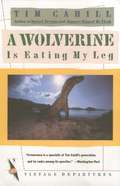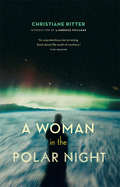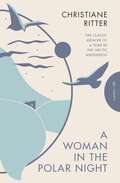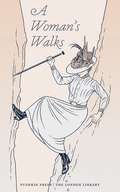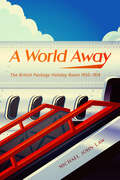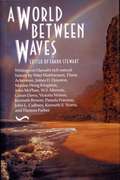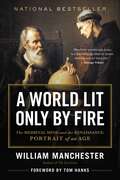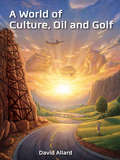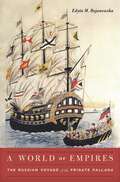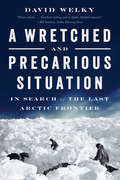- Table View
- List View
A Walk in the Woods: Rediscovering America on the Appalachian Trail (Bryson Ser. #8)
by Bill BrysonNEW YORK TIMES BESTSELLER • The classic chronicle of a &“terribly misguided and terribly funny&” (The Washington Post) hike of the Appalachian Trail, from the author of A Short History of Nearly Everything and The Body &“The best way of escaping into nature.&”—The New York Times Back in America after twenty years in Britain, Bill Bryson decided to reacquaint himself with his native country by walking the 2,100-mile Appalachian Trail, which stretches from Georgia to Maine. The AT offers an astonishing landscape of silent forests and sparkling lakes—and to a writer with the comic genius of Bill Bryson, it also provides endless opportunities to witness the majestic silliness of his fellow human beings. For a start there&’s the gloriously out-of-shape Stephen Katz, a buddy from Iowa along for the walk. But A Walk in the Woods is more than just a laugh-out-loud hike. Bryson&’s acute eye is a wise witness to this beautiful but fragile trail, and as he tells its fascinating history, he makes a moving plea for the conservation of America&’s last great wilderness. An adventure, a comedy, and a celebration, A Walk in the Woods is a modern classic of travel literature. NOW A MAJOR MOTION PICTURE
A Walking Tour of the Georgetown Set
by Rick MassimoThe tony, leafy neighborhood of Georgetown along the Potomac river in Washington, D.C. has been influential in American history since the 18th century when it was a thriving seaport. But during the Cold War, following World War II and up until the end of the 20th century, it was home to the Capitol's most influential players in government, spycraft, journalism, and the arts. Within less than a square mile were located the red brick Federal era homes of the best and the brightest, most of them close friends and frequent dinner companions. They came to be known as the "Georgetown Set", despised by Richard Nixon for their Ivy League, patrician clannishness, their secret "old boy" arrogance, and their unfettered access to the highest levels of power in the city.The inner circle included Phillip and Katharine Graham, owners of the Washington Post; the columnists Joe and Stewart Alsop; The Bundy brothers; powerbroker and railroad scion Averrill Harriman; Secretary of State John Foster Dulles; Jack and Jackie Kennedy; and many more spooks, G men, Senators, and Supreme Court Justices were members of this elite club. Now, for the first time, author Richard Massimo takes us on a walking tour of the neighborhood where the Georgetown Set lived, including a map, recent photos of each house, and sketches of each inhabitant. Spend an afternoon walking the brick sidewalks of Georgetown and you'll see where these historic figures resided. &“The hand that mixes the Georgetown martini is time and again the hand that guides the destiny of the Western world.&” –Henry Kissinger
A Wall Of Names: The Story Of The Vietnam Veterans Memorial
by Judy DonnellyStep into Reading with A WALL OF NAMES: The Story of the Vietnam Veterans Memorial "Why did you die and not me?" This is a note to a dead soldier from an old friend. It is one of hundreds of notes left every year beside the Vietnam Veterans Memorial -- a wall curved with the names of all the US soldiers who died in the Vietnam War. The wall was built to honor these men and women and to heal the deep wounds left by the longest and most hated war ever fought by Americans. Here's the dramatic story of how the wall came to be and what Vietnam meant to our country in the war-torn years of the 60s. Select picture descriptions added and captions
A Wall of Names: The Story of the Vietnam Veterans Memorial
by Judy DonnellySurveys the history of the Vietnam War, chronicles the construction of the Vietnam Memorial, and discusses what the Memorial means to many Americans.
A Wealth of Buildings: Volume I: 1066–1688
by Richard BarrasThis two-volume book explores how the great buildings of England bear witness to a thousand years of the nation's history. In every age, investment in iconic buildings reaches a climax when the prevailing mode of production is operating most effectively, surplus wealth is most plentiful, and the dominant class rules supreme. During such periods of stability and prosperity, the demand for new buildings is strong, structural and stylistic innovations abound, and there is fierce competition to build for lasting fame. Each such climax produces a unique vintage of hegemonic buildings that are monuments to the wealth and power of those who ruled their world. This first volume provides an introduction to the study of wealth accumulation over the past millennium. There follow three case studies of iconic building investment from the eleventh to the seventeenth century. During the eleventh and twelfth centuries the conquering Norman kings and barons erected castles throughout the country to cement their feudal power. During the thirteenth and fourteenth centuries the great wealth of the ecclesiastical estates funded the lavish construction of Gothic cathedrals and abbeys. During the sixteenth and early seventeenth centuries Tudor and Jacobean magnates vied to build the most magnificent palaces and prodigy houses. The English Revolution brought this era to a close.
A Wealth of Buildings: Volume II: 1688–Present
by Richard BarrasThis two-volume book explores how the great buildings of England bear witness to a thousand years of the nation's history. In every age, investment in iconic buildings reaches a climax when the prevailing mode of production is operating most effectively, surplus wealth is most plentiful, and the dominant class rules supreme. During such periods of stability and prosperity, the demand for new buildings is strong, structural and stylistic innovations abound, and there is fierce competition to build for lasting fame. Each such climax produces a unique vintage of hegemonic buildings that are monuments to the wealth and power of those who ruled their world. This first volume provides an introduction to the study of wealth accumulation over the past millennium. There follow three case studies of iconic building investment from the eleventh to the seventeenth century. During the eleventh and twelfth centuries the conquering Norman kings and barons erected castles throughout the country to cement their feudal power. During the thirteenth and fourteenth centuries the great wealth of the ecclesiastical estates funded the lavish construction of Gothic cathedrals and abbeys. During the sixteenth and early seventeenth centuries Tudor and Jacobean magnates vied to build the most magnificent palaces and prodigy houses. The English Revolution brought this era to a close.
A Wedding Like No Other: Inspiration for Creating a Unique, Personal, and Unforgettable Celebration
by Peggy Post Peter PostDestination weddings planned in exotic locales, intimate weddings organized on a shoestring budget, full-scale galas with guests from all over the globe. . . . In A Wedding Like No Other, read the stories of some of the most incredible, romantic ceremonies and receptions collected by the wedding etiquette experts at the Emily Post Institute. As different as they all are, the stories featured here are examples of how a wedding can be heartwarming and unique—even if everything doesn't go exactly as planned. In each one, the bride and groom make a determined effort for their wedding day to be an expression of their tastes and personalities, often in the face of unexpected obstacles. And in every case, the end result is a wonderful and memorable experience for the couple and for everyone else involved. Let these stories help inspire your own big day. The creative vows, cakes, toasts, and more described in these pages will spark your own ideas and help you personalize every detail of your wedding. Also, each story is followed by a short advice section, offering insights and general wisdom on a large variety of topics from picking the venue to selecting the menu. Go beyond the standard, the expected, and make your big day a cherished, uplifting, unforgettable experience. You already have a love like no other, so celebrate it with a wedding like no other.
A Week at the Airport
by Alain De BottonGiven unprecedented access to one of the world’s busiest airports as a “writer-in-residence,” Alain de Botton found it to be a showcase for many of the major crosscurrents of the modern world—from our faith in technology to our destruction of nature, from our global interconnectedness to our romanticizing of the exotic. He met travelers from all over and spoke with everyone from baggage handlers to pilots to the airport chaplain. Weaving together these conversations and his own observations—of everything from the poetry of room service menus to the eerie silence in the middle of the runway at midnight—de Botton has produced an extraordinary meditation on a place that most of us never slow down enough to see clearly. Lavishly illustrated in color by renowned photographer Richard Baker, A Week at the Airport reveals the airport in all its turbulence and soullessness and—yes—even beauty.
A Week on the Concord and Merrimack Rivers
by Henry David Thoreau H. Daniel PeckThoreau's account of his 1839 boat trip is a finely crafted tapestry of travel writing, essays, and lyrical poetry. Thoreau interweaves descriptions of natural phenomena, the rural landscape, and local characters with digressions on literature and philosophy, the Native American and Puritian histories of New England, the Bhagavad Gita, the imperfections of Christianity, and many other subjects. Although it shares many of the themes in Thoreau's classic WALDEN, A WEEKoffers an alternative perspective on his analaysis of the relationship between nature and culture.
A Week on the Concord and Merrimack Rivers (Dover Thrift Editions)
by Henry David ThoreauBased on an 1839 boat trip Thoreau took with his brother from Concord, Massachusetts, to Concord, New Hampshire, and back, this classic of American literature is not only a vivid narrative of that journey, it is also a collection of thought-provoking observations on such diverse topics as poetry, literature and philosophy, Native American and Puritan histories of New England, friendship, sacred Eastern writings, traditional Christianity, and much more.Written, like Walden, while Thoreau lived at Walden Pond, and published in 1849, A Week (his first book) shares many themes with Walden, published in 1854. Both dramatize the process of self-renewal in nature and resolutely rail against the official culture and politics of the "trivial Nineteenth Century." Blending keen observation with a wealth of perceptive and informed reflections, Thoreau develops a continuous and lyrical dialogue between the past and present, as particular scenes on shore trigger reflections on the region's history and legends.Originally conceived as a travel book, A Week eventually became much more -- one of the most intellectually ambitious works of 19th-century America, and a requiem for Thoreau's brother John, who died from a sudden illness in 1842.Of Thoreau and this work, Ralph Waldo Emerson said, "H. D. Thoreau is a great man in Concord, a man of original genius and character. . . . I think it [A Week. . .] is a book of wonderful merit, which is to go far and last long."
A Wheelchair Rider's Guide: San Francisco Bay and the Nearby Coast
by Bonnie LewkowiczMany natural areas, parks, urban waterfronts, and hundreds of miles of trails along the California coast and on San Francisco Bay are now accessible to wheelchair riders and others with limited mobility. This book describes more than a hundred beautiful and interesting sites around the entire bay and on the ocean between Point Reyes and Santa Cruz. You will find opportunities to watch birds and other wildlife, picnic on blufftops and on shaded lawns by the water, camp on an island, fish off piers, watch sunsets over the surf, learn about the region's natural and human history, and enjoy yourself in many other ways. Too often, wheelchair riders hesitate to explore far from home because they don't know about barrier-free routes and the availability of restrooms and other facilities. The Coastal Conservancy funded this guide as part of its public access program, to encourage greater enjoyment of the natural riches we all hold in common.
A Wild Idea: How the Environmental Movement Tamed the Adirondacks
by Brad EdmondsonA Wild Idea shares the complete story of the difficult birth of the Adirondack Park Agency (APA). The Adirondack region of New York's rural North Country forms the nation's largest State Park, with a territory as large as Vermont. Planning experts view the APA as a triumph of sustainability that balances human activity with the preservation of wild ecosystems. The truth isn't as pretty. The story of the APA, told here for the first time, is a complex, troubled tale of political dueling and communities pushed to the brink of violence. The North Country's environmental movement started among a small group of hunters and hikers, rose on a huge wave of public concern about pollution that crested in the early 1970s, and overcame multiple obstacles to "save" the Adirondacks. Edmondson shows how the movement's leaders persuaded a powerful Governor to recruit planners, naturalists, and advisors and assign a task that had never been attempted before. The team and the politicians who supported them worked around the clock to draft two visionary land-use plans and turn them into law. But they also made mistakes, and their strict regulations were met with determined opposition from local landowners who insisted that private property is private.A Wild Idea is based on in-depth interviews with five dozen insiders who are central to the story. Their observations contain many surprising and shocking revelations. This is a rich, exciting narrative about state power and how it was imposed on rural residents. It shows how the Adirondacks were "saved," and also why that campaign sparked a passionate rebellion.
A Wind from the North: The Life of Henry the Navigator
by Ernle BradfordThe captivating biography of Prince Henry of Portugal, the navigator and explorer who helped usher in the Age of Discovery. Before Columbus, Vespucci, and Sir Francis Drake, there was Henry the Navigator. Pirate hunter, intrepid explorer, and ship designer, the Portuguese prince was one of the great innovators who pioneered the Age of Discovery. In an effort to locate the mythic kingdom of Prester John, Prince Henry organized voyages into the Southern Atlantic and developed a new kind of ship, the caravel, specifically for the task. His explorations yielded riches and fame for Portugal, as well as the discovery of Madeira and the Canary Islands. Yet the scope of his contribution to the world is often overshadowed by other figures. In this expertly researched biography, Ernle Bradford brings to light the captivating tale of a pioneer who initiated an era of exploration and forever changed the course of history.
A Winter in Arabia: A Journey Through Yemen
by Freya StarkOne of the most unconventional and courageous explorers of her time, Freya Stark chronicled her extraordinary Travels in the Near East, establishing herself as a twentieth century heroine. A Winter in Arabia recounts her 1937-8 expedition in what is now Yemen, a journey which helped secure her reputation not only as a great travel writer, but also as a first-rate geographer, historian, and archaeologist. There, in the land whose "nakedness is clothed in shreds of departed splendor," she and two companions spent a winter in search of an ancient South Arabian city. Offering rare glimpses of life behind the veil-the subtleties of business and social conduct, the elaborate beauty rituals of the women, and the bitter animosities between rival tribes, Freya Stark conveys the "perpetual charm of Arabia ... that the traveler finds his own level there simply as a human being."
A Wolverine Is Eating My Leg (Vintage Departures)
by Tim CahillCahill is great! He is the P.J. O'Rourke of the outdoors! Fearless and hell-bent on overcoming all obstacles in his path, Cahill takes us to the oddest and scariest adventures nature has to offer.From the Trade Paperback edition.
A Woman in the Polar Night
by Christiane RitterIn this extraordinary adventure, a reluctant visitor to the Arctic thrives in the awesome and unforgiving landscape.<P><P>In 1933, Christiane Ritter, a painter from Austria, travelled to Spitsbergen, an Arctic island north of Norway, to be with her husband. He had been taking part in a scientific expedition and stayed on to hunt and fish. "Leave everything as it is and follow me to the Arctic," he wrote to his wife; but for Christiane, "as for all central Europeans, the Arctic was just another word for freezing and forsaken solitude. I did not follow at once." Eventually she gave in, lured by his compelling stories about the remarkable wildlife and alluring light shows. She says: "They told of journeys by water and over ice, of the animals and the fascination of the wilderness, of the strange light over the landscape, of the strange illumination of one's own self in the remoteness of the polar night. In his descriptions there was practically never any mention of cold or darkness, of storms or hardships."
A Woman in the Polar Night (Pushkin Press Classics)
by Christiane Ritter&“An epic story, elegantly told and full of mystery.&” — Maggie Shipstead, author of Great CircleA rediscovered classic memoir - the mesmerizingly beautiful account of one woman's year spent living in a remote hut in the ArcticThis rediscovered classic memoir tells the incredible tale of a woman defying society's expectations to find freedom and peace in the adventure of a lifetime.In 1934, the painter Christiane Ritter leaves her comfortable life in Austria and travels to the remote Arctic island of Spitsbergen, to spend a year there with her husband. She thinks it will be a relaxing trip, a chance to 'read thick books in the remote quiet and, not least, sleep to my heart's content', but when Christiane arrives she is shocked to realize that they are to live in a tiny ramshackle hut on the shores of a lonely fjord, hundreds of miles from the nearest settlement, battling the elements every day, just to survive.At first, Christiane is horrified by the freezing cold, the bleak landscape the lack of equipment and supplies... But as time passes, after encounters with bears and seals, long treks over the ice and months on end of perpetual night, she finds herself falling in love with the Arctic's harsh, otherworldly beauty, gaining a great sense of inner peace and a new appreciation for the sanctity of life.
A Woman's Journey Round the World: From Vienna to Brazil, Chili, Tahiti, China, Hindostan, Persia, and Asia Minor
by Ida PfeifferThis scarce antiquarian book is a facsimile reprint of the original. Due to its age, it may contain imperfections such as marks, notations, marginalia and flawed pages. Because we believe this work is culturally important, we have made it available as part of our commitment for protecting, preserving, and promoting the world's literature in affordable, high quality, modern editions that are true to the original work.
A Woman's Walks
by Lady Colin CampbellA book of exploration and discovery, celebrating the 175th anniversary of The London Library.From young men seeking outdoor adventure to intrepid ladies of a certain age discovering other cultures, Victorian explorers were starting to develop a more personal kind of travelogue. In A Woman's Walks, Lady Colin Campbell takes us on a voyage of exploration through her inner landscape - as well as through Italy, France, Switzerland, Austro-Hungary, London, and the English countryside.The books in "Found on the Shelves" have been chosen to give a fascinating insight into the treasures that can be found while browsing in The London Library. Now celebrating its 175th anniversary, with over seventeen miles of shelving and more than a million books, The London Library has become an unrivalled archive of the modes, manners and thoughts of each generation which has helped to form it.From essays on dieting in the 1860s to instructions for gentlewomen on trout-fishing, from advice on the ill health caused by the "modern" craze of bicycling to travelogues from Norway, they are as readable and relevant today as they were more than a century ago.
A World Away: The British Package Holiday Boom, 1950–1974
by Michael John LawThe 1950s and 1960s were a transformative period in Britain, and an important part of this was how Britons’ lives were changed when they began flying abroad for their holidays. In A World Away Michael John Law investigates how something that previously only the rich could afford became available to working-class holidaymakers.A World Away moves beyond the big players in the tourist industry and technical accounts of the airplanes used by tour operators to tell the histories of the people who were there, both tourists and tour guides, using their personal testimonies. Until now there has been uncertainty about the identity of these new tourists: some feared they were working-class intruders who might invade the pristine destinations favoured by the elite; others claimed that most were from the middle class. Using new data derived from flight accident investigations, Law explains the complex origins of these new flyers. In British society this unprecedented mobility could not go unpunished, and the new tourists were lampooned in books and newspapers aimed at the middle classes. Law shows how popular culture, movies, and music influenced the decision to travel, and what actually happened when these new holidaymakers went abroad.Law investigates the package tour industry from its mid-century origins through its inherent weaknesses, governmental interference, and unforeseen world events that contributed to its partial failure in the early 1970s. A World Away provides the definitive account of this important change in postwar British society.
A World Between Waves: Politics And Extinction On A Hawaiian Island
by Frank StewartA World Between Waves is a collection of essays on the natural history of Hawaii by some of America's most renowned writers. It is a testament to the biological and geological wealth of this unique and threatened island landscape, and a passionate call to action on behalf of what may soon be gone.
A World Lit Only by Fire: The Medieval Mind and the Renaissance - Portrait of an Age
by William ManchesterA "lively and engaging" history of the Middle Ages (Dallas Morning News) from the acclaimed historian William Manchester, author of The Last Lion. From tales of chivalrous knights to the barbarity of trial by ordeal, no era has been a greater source of awe, horror, and wonder than the Middle Ages. In handsomely crafted prose, and with the grace and authority of his extraordinary gift for narrative history, William Manchester leads us from a civilization tottering on the brink of collapse to the grandeur of its rebirth: the dense explosion of energy that spawned some of history's greatest poets, philosophers, painters, adventurers, and reformers, as well as some of its most spectacular villains."Manchester provides easy access to a fascinating age when our modern mentality was just being born." --Chicago Tribune
A World of Culture, Oil and Golf
by David AllardTwists & turns on the world’s roads to oil and golf .... this book takes you there! • World cultures; people and places tourists do not typically see • Oil business risk and wildcat wells • Rebels, jungle, desert and offshore • Golf in strange places; even if your caddy speaks no English “JR Ewing in Dallas, Daniel Plainview in There Will Be Blood – fictional oil men live oversized lives. David Allard lived a life in oil but the glamour was different – early morning shifts on a rig in the South China Sea, a handful of pistachios with friendly locals while drilling in Turkey, a cold beer in Cairo after a rough drive exploring a remote oasis. All through this oil and gas adventure, he dreams of being at home with his wife, her garden, and his young son. This is the real thing – meticulously documented and full of the little details that really matter.” Lisa Margonelli, author of Oil on the Brain. “A World of Culture, Oil and Golf is a fascinating look into the global oil business and what it’s like to be an insider traveling the world and navigating the amazing array of locales and personalities of the most valuable commodity mankind has ever traded. The book is an easy, fast-paced read and is entertaining and informative from the first page to the last. I truly enjoyed it and would recommend it to readers of any age.David W. Miller II, author of Hard Knocks MBA: The Search for Business Success and Job Satisfaction and Before and After: Auto Restoration Done RIGHT! With over 30 years in the oil business as a geologist, David Allard takes you on a wild worldwide adventure. From the oil patch of Midland Texas, to Houston, around the world and back to the USA; enjoy the trip!
A World of Empires: The Russian Voyage of the Frigate <i>Pallada</i>
by Edyta M. BojanowskaMany people are familiar with American Commodore Matthew Perry’s expedition to open trade relations with Japan in the early 1850s. Less well known is that on the heels of the Perry squadron followed a Russian expedition secretly on the same mission. Serving as secretary to the naval commander was novelist Ivan Goncharov, who turned his impressions into a book, The Frigate Pallada, which became a bestseller in imperial Russia. In A World of Empires, Edyta Bojanowska uses Goncharov’s fascinating travelogue as a window onto global imperial history in the mid-nineteenth century. Reflecting on encounters in southern Africa’s Cape Colony, Dutch Java, Spanish Manila, Japan, and the British ports of Singapore, Hong Kong, and Shanghai, Goncharov offers keen observations on imperial expansion, cooperation, and competition. Britain’s global ascendancy leaves him in equal measures awed and resentful. In Southeast Asia, he recognizes an increasingly interlocking world in the vibrant trading hubs whose networks encircle the globe. Traveling overland back home, Goncharov presents Russia’s colonizing rule in Siberia as a positive imperial model, contrasted with Western ones. Slow to be integrated into the standard narrative on European imperialism, Russia emerges here as an increasingly assertive empire, eager to position itself on the world stage among its American and European rivals and fully conversant with the ideologies of civilizing mission and race. Goncharov’s gripping narrative offers a unique eyewitness account of empire in action, in which Bojanowska finds both a zeal to emulate European powers and a determination to define Russia against them.
A Wretched and Precarious Situation: In Search of the Last Arctic Frontier
by David WelkyA Kirkus Reviews Best Nonfiction Book of 2016 A remarkable true story of adventure, betrayal, and survival set in one of the world’s most inhospitable places. In 1906, from atop a snow-swept hill in the ice fields northwest of Greenland, hundreds of miles from another human being, Commander Robert E. Peary spotted a line of mysterious peaks looming in the distance. He called this unexplored realm “Crocker Land.” Scientists and explorers agreed that the world-famous explorer had discovered a new continent rising from the frozen Arctic Ocean. Several years later, two of Peary’s disciples, George Borup and Donald MacMillan, assembled a team of amateur adventurers to investigate Crocker Land. Before them lay a chance at the kind of lasting fame enjoyed by Magellan, Columbus, and Captain Cook. While filling in the last blank space on the globe, they might find new species of plants or animals, or even men; in the era of Jules Verne and H. G. Wells, anything seemed possible. Renowned scientific institutions, and even former president Theodore Roosevelt, rushed to endorse the expedition. What followed was a sequence of events that none of the explorers could have imagined. Trapped in a true-life adventure story, the men endured howling blizzards, unearthly cold, food shortages, isolation, a fatal boating accident, a drunken sea captain, disease, dissension, and a horrific crime. But the team pushed on through every obstacle, driven forward by the mystery of Crocker Land and faint hopes that they someday would make it home. Populated with a cast of memorable characters, and based on years of research in previously untapped sources, A Wretched and Precarious Situation is a harrowing Arctic narrative unlike any other.
